The ASA Fellow Award—Revisited
Robert Starbuck, ASA Fellows Committee Chair
The 2011 ASA Fellow awards were presented at JSM in Miami Beach, Florida. Here, I present a brief update to previous articles on this subject appearing in Amstat News. A few corrections have been made to previous counts of Fellow nominees and awardees.
Employment Sector
In the range of years shown, the percentages of ASA members by employment sector have remained relatively stable: 42% Academe, 47% Business/Industry, and 11% Government.
The counts of ASA Fellow awards given by employment sector since 2004 are presented in Table 1 and Figure 1.
Table 1—Counts and Percentages of ASA Fellow Awards
Figure 1. Percentage of ASA Fellows awarded by employment sector
The percentages of Fellows awarded by employment sector relative to the percentages of ASA membership by sector are shown in Figure 2.
Figure 2. Percentage of ASA Fellows awarded / percentage of ASA membership by employment sector
The counts and percentages of Fellow nominations by employment sector are shown in Table 2. The number of nominations from business/industry was the lowest in the seven years included in this report.
Table 2—Counts and Percentages of ASA Fellow Nominations
So, how have the nominations fared in each of the employment sectors? As shown in Table 3 and Figure 3, nominations submitted this year from the business/industry and government sectors did not fare as well as nominations from academe.
Table 3—Percentages of Successful ASA Fellows Nominations
Figure 3. Percentage of successful ASA Fellows nominations by employment sector
Gender
The membership of the ASA has changed significantly in regard to the percentages of females and males, as illustrated in Table 4 and Figure 4. The table looks at the current ASA membership and subsets that joined the ASA in ranges of previous years.
Table 4—Percentages of ASA Membership by Gender
Figure 4. Percentages of current ASA members by gender
Assuming the number of departures from ASA membership has been proportional to gender (i.e., females and males are equally likely to discontinue or retain ASA membership), there has been a noticeable increase in the percentage of female members.
The ASA Fellow Award is almost always given to ASA members who have reached mid-career, and as such, the gender percentages of ASA membership that are appropriate reference points for years 2004–2011 are those reflecting members who joined the ASA on or before 1994–2000. Thus, the relevant reference percentages for females for Fellow nominations and awards are in the 20% to 23% range.
The counts and percentages by gender of ASA Fellow nominations in 2004–2011 are presented in Table 5.
Table 5—Counts and Percentages of ASA Fellow Nominations by Gender
The percentages of female nominees have been slightly below the reference percentages for five of the eight years, and were substantially below in 2009.
The counts and percentages by gender of ASA Fellow awards in 2004–2011 are presented in Table 6 and the percentages are presented in Figure 5.
Table 6—Counts and Percentages of ASA Fellow Awards by Gender
Figure 5. Percentage of ASA Fellows awarded by gender
The percentages of female Fellow awardees have been generally reflective of the reference percentages. As shown in Table 7 and Figure 6, the decline in the percentage of female Fellow awardees in 2009 was due to the lower percentage of female Fellow nominations. For nominees, the average chance of success is somewhat higher for females.
Table 7—Percentage of Successful ASA Fellow Nominations by Gender
Figure 6. Percentage of successful ASA Fellow nominations by gender
Conclusion
The number of Fellow nominations from a given employment sector or gender is a key factor in determining the number of awards from that sector. The other obvious key factor is the quality of the nominations. To increase the number of Fellow awards in an employment sector or gender to achieve parity in the percentages of awards relative to the percentages of ASA membership (see Figures 2 and 5), the number of nominations from that sector or gender needs to increase, and these nominations need to be of good quality.
The ASA Fellow award is a significant recognition of contributions to the statistics profession and should reflect the constituency of the ASA membership. If you or others you know are deserving of this award, please participate in and encourage others to participate in the award nomination process.

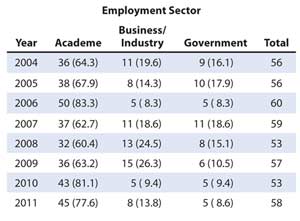
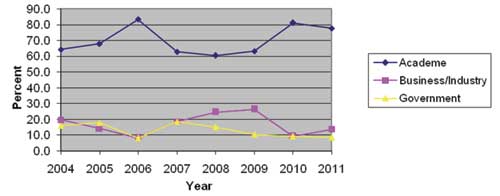
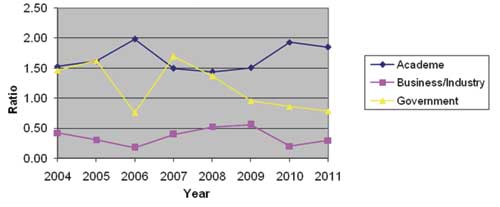
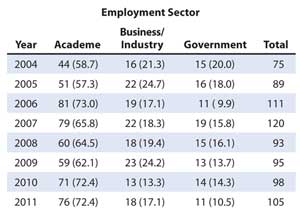
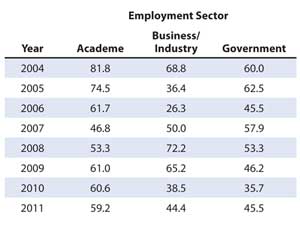
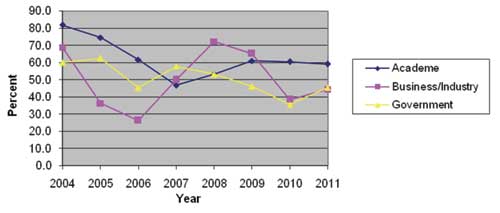
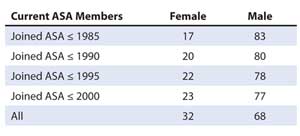
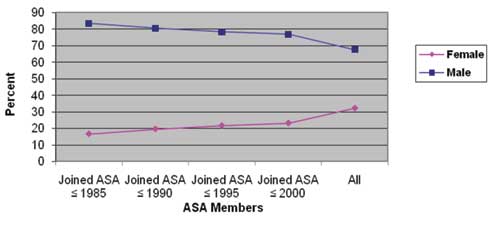


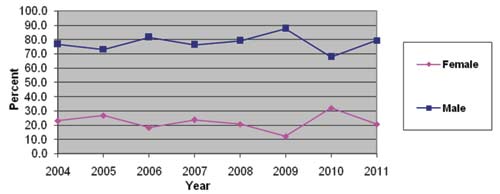
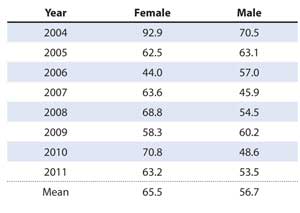
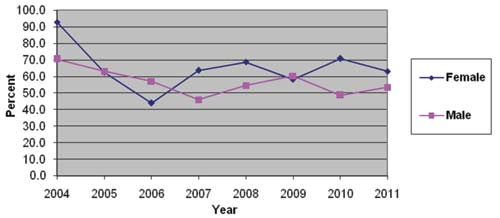









I agree that nominees from all sectors and both genders need to be given serious consideration and that increasing the number and quality of the nominations should increase the number elected. However we should not fall into the trap of saying that sectors should be elected in proportion to their representation in ASA. Even with high quality nominations in all sectors, it is not necessarily the case that each sector would have a proportionate number of candidates that meet the standards for fellowship. I do beleive there was a bias toward academia up until the late 1990s. But that has changed as has the requirements for fellowship. There has been an increasing effort to encourage nominations and the fellowship committee seems to much better represent all sectors of ASA. I think the association and the committee is doing an excellent job with regard to this prestigeous honor.
I do not see how you get the 47 percent business/industry that is in the text from Table 1
Bob, Thank you for another interesting and thorough analysis of the ASA Fellow Arard program. I particularly appreciated your efforts to identify which span of membership years was most relevent for interpreting the recent year results.
Welcome!
Amstat News is the monthly membership magazine of the American Statistical Association, bringing you news and notices of the ASA, its chapters, its sections, and its members. Other departments in the magazine include announcements and news of upcoming meetings, continuing education courses, and statistics awards.
ASA HOME
Departments
Archives
ADVERTISERS
PROFESSIONAL OPPORTUNITIES
FDA
US Census Bureau
Software
STATA
QUOTABLE
“ My ASA friendships and partnerships are some of my most treasured, especially because the ASA has enabled me to work across many institutional boundaries and
with colleagues from many types of organizations.”
— Mark Daniel Ward
Editorial Staff
Managing Editor
Megan Murphy
Graphic Designers / Production Coordinators
Olivia Brown
Meg Ruyle
Communications Strategist
Val Nirala
Advertising Manager
Christina Bonner
Contributing Staff Members
Kim Gilliam
Contact us
Amstat News
American Statistical Association
732 North Washington Street
Alexandria, VA 22314-1904
(703) 684-1221
www.amstat.org
Address Changes
Amstat News Advertising